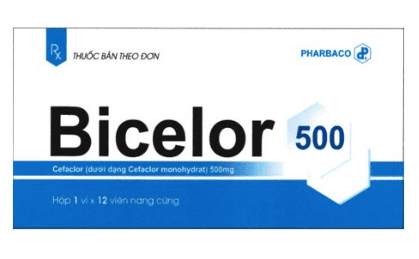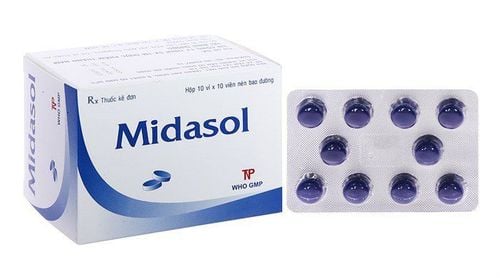This is an automatically translated article.
Uribel is used to relieve discomfort, pain, frequent urge to urinate and urinary spasms caused by lower urinary tract infections or medical procedures on the urinary tract. Knowing the basic information such as ingredients, indications, contraindications, doses and unwanted side effects of Uribel will help patients and their families improve the effectiveness of treatment.1. What is Uribel?
Uribel medicine is made in the form of soft capsules, with the main ingredients including:
Active ingredients:
Methenamine content 118mg. Sodium Phosphate Monobasic 40.8mg. Phenyl Salicylate 36mg. Methylene Blue (Methylene Blue) 10mg. Hyoscyamine Sulfate 0.12mg. Excipients: Dicalcium Phosphate, FD&C Blue
1, FD&C Red
3, Gelatin, Magnesium Stearate, Microcrystalline Cellulose, Povidone, Propylene Glycol, Shellac, Silicon Dioxide, Sodium Hydroxide, Stearic Acid and Titanium Dioxide just enough for 1 capsule.
Mechanism of action:
Methenamine decomposes in acidic urine, releasing Formaldehyde to help kill or inhibit bacteria. It is well absorbed from the gastrointestinal tract. Sodium Phosphate Monobasic is an acid reducing agent, which helps maintain the acidic pH of the urine necessary for the breakdown of Methenamine. Phenyl Salicylate releases salicylate, a mild pain reliever. Methylene Blue is well absorbed from the gastrointestinal tract and rapidly reduced to Leukomethylene blue, which is stabilized in some conjugated forms in the urine, thereby having a diuretic effect, but has a weak effect. Hyoscyamine Sulfate is a parasympathetic that relaxes smooth muscles and thus produces an antispasmodic effect. It is well absorbed from the gastrointestinal tract and is rapidly distributed throughout the tissues of the body.
2. What does Uribel do?
Uribel is indicated for the treatment of the following cases:
Relieve discomfort, pain, frequent urge to urinate and urinary spasms caused by lower urinary tract infections. Relieving urinary tract symptoms due to diagnostic and therapeutic procedures on the urinary tract.
3. Contraindications of the drug Uribel:
Hypersensitivity to any component of the drug Uribel. History of allergy to other drugs containing Methenamine, Sodium Phosphate Monobasic, Phenyl Salicylate, Methylene Blue and Hyoscyamine Sulfate. Patients with a history or current medical conditions such as arrhythmia, congestive heart failure, coronary artery disease and mitral stenosis, gastrointestinal obstruction, glaucoma; myasthenia gravis, acute urinary retention, and acute urinary retention in bladder neck obstruction due to prostatic hypertrophy.
4. Dosage and how to use Uribel
Adults:
Recommended dose: Take 1 tablet/time x 4 times/day. Drink with plenty of water. Children:
Children ≥ 6 years old: Dosage must be prescribed by a specialist. Children < 6 years: Uribel is not recommended.
5. Notes when using Uribel
Using Uribel in high doses or for a long time, can cause side effects such as:
Cardiovascular: Increased heart rate, flushing. Central nervous system: Blurred vision, dizziness, somnolence. Genitourinary system: Dysuria, acute urinary retention. Gastrointestinal: Dry mouth, nausea and vomiting. Respiratory: Shortness of breath or difficulty breathing. Allergic reactions: Severe itching, rash, dizziness, swelling, severe may lead to anaphylaxis. This medicine can cause urine and sometimes stools to turn from blue to green. However, this effect is harmless and will subside once the drug is stopped. The drug should be discontinued when detecting the above symptoms or other abnormalities after using Uribel. Patients or family members should promptly notify the treating doctor about the use of Uribel or immediately go to the nearest medical facility for timely treatment.
Note the use of Uribel in the following subjects:
Use caution when using Uribel in children under 6 years old, the elderly, patients intolerant of Belladonna's Alkaloids or Salicylates, slow gastric emptying. Pregnant women: According to the classification of the US Food and Drug Administration (FDA), the active ingredient in Uribel is in Group C, a group with evidence of risks on pregnancy such as birth defects, miscarriage. pregnancy or other adverse effects. Therefore, Uribel capsules should only be used by pregnant women when absolutely necessary. Lactation: Studies suggest that the active ingredients in Uribel may pass into breast milk. Therefore, Uribel should be used with caution in nursing mothers and only when clearly needed. Drivers or workers who operate machinery may experience a side effect such as blurred vision, dizziness, drowsiness....after using Uribel, therefore it is recommended not to use Uribel before entering. while working. Interactions with other drugs:
Due to the effect of Uribel on gastrointestinal motility and gastric emptying, it may reduce the absorption of thiazide diuretics or urine alkalinizers. Concurrent use of Muscarinic receptor antagonists can enhance the anti-infective effect of the active ingredient Hyoscyamine contained in Uribel. Antacids or anti-diarrheal medicines can reduce the absorption of the active ingredient Hyoscyamine and reduce the effectiveness of the active ingredient in Uribel. Use Uribel at least 2 hours after using Ketoconazole. Concomitant administration of Uribel and Monoamine oxidase (MAO) inhibitors may increase the adverse effects of muscarinic receptor antagonism. Concomitant use of narcotic opioid analgesics and Uribel may increase the risk of severe constipation. Concomitant use of Sulfonamide and Uribel may cause precipitation with Formaldehyde in the urine, increasing the risk of crystalluria. Above is the necessary information about the composition, uses, dosage and unwanted effects of Uribel medicine. Patients and family members should carefully read the instructions on the package of Uribel, and consult with their doctor or pharmacist before deciding to use.
Please dial HOTLINE for more information or register for an appointment HERE. Download MyVinmec app to make appointments faster and to manage your bookings easily.













